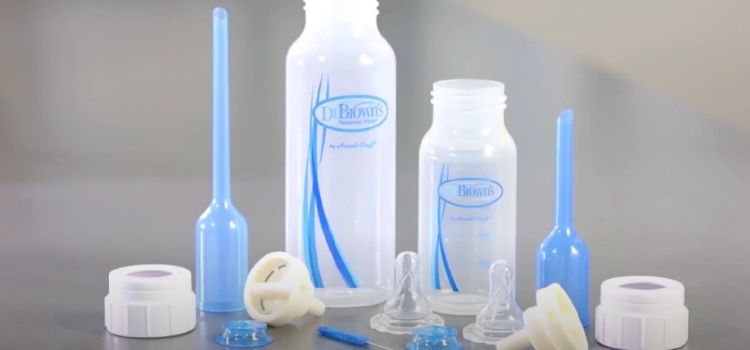As an Amazon Associate I earn from qualifying purchases.
Parents have long trusted Dr. Brown’s bottles for their new design and ability to reduce colic and gas in babies. However, like any baby product, it’s essential to know when to replace them to ensure the safety and well-being of your little one. In this blog post, we’ll discuss how often you should replace Dr. Brown’s bottles and provide some helpful tips for maintaining them.

Why Replace Dr. Brown Bottles?
Over time, baby bottles can start to show signs of wear and tear. The nipples can become worn out or develop cracks, and the bottles may accumulate scratches or discoloration. These issues can affect the bottles’ performance and cleanliness, compromising their ability to provide a safe and hygienic feeding experience.
Signs It’s Time to Replace Dr. Brown Bottles

While there is no set rule for exactly when to replace your Dr. Brown bottles, there are some signs that indicate it may be time for a new set:
- Nipple Condition: Check the nipples regularly for any damage, such as cracks, tears, or enlarged holes. If you notice any of these issues, it’s time to replace the nipple. A damaged nipple can affect the flow of milk or formula, potentially causing feeding difficulties for your baby.
- Bottle Condition: Inspect the bottles for scratches, discoloration, or cloudiness. These can be signs of wear and can make it more difficult to clean the bottles effectively. If you notice significant damage or the bottles are no longer clear and transparent, it’s recommended to replace them.
- Odor or Stains: If you find that no matter how much you clean and sanitize the bottles, they still retain an odor or have stubborn stains, it may be a sign that it’s time for a fresh set. Lingering odors or stains can indicate bacterial growth and pose a risk to your baby’s health.
Tips for Maintaining Dr. Brown Bottles

To extend the lifespan of your Dr. Brown bottles and ensure their optimal performance, here are some helpful tips:
- Follow Cleaning and Sterilization Guidelines: Clean the bottles thoroughly after each use, paying particular attention to the nipples and any hard-to-reach areas. Sterilize them regularly according to the manufacturer’s guidelines. Proper cleaning and sterilization practices can help prevent bacterial growth and prolong the life of bottles.
- Handling: Be careful when handling the bottles, and avoid using irritating materials or scrub brushes that can scratch the surfaces. Scratches can create hiding places for bacteria and make it harder to clean the bottles effectively.
- Store Properly: After washing and sterilizing, allow the bottles to air dry completely before keeping them. Store them in a clean and dry environment, away from direct sunlight and potential contaminants.
- Regularly Inspect and Replace Parts: Routinely check the bottles, nipples, and other components for inks of wear and tear. Replace any damaged or worn-out parts instantly to maintain the bottles’ performance and ensure your baby’s safety.
Choosing the Right Replacement Bottles

When it’s time to replace your Dr. Brown bottles, there are a few factors to consider:
- Size and Capacity: Dr. Brown’s bottles come in various sizes and capacities, so make sure to choose the right one for your growing baby.
- Material: Dr. Brown offers both glass and plastic options for their bottles. Glass is more durable and easier to clean, but plastic is lighter and more convenient for on-the-go use.
- Anti-Colic Features: If your baby has colic or gas issues, consider getting a bottle with Dr. Brown’s patented vent system for added relief.
- Personal Preference: Ultimately, the best replacement bottle is one that works well for you and your baby. If your baby has been using Dr. Brown’s bottles with success, sticking with the brand may be the best option for you.
Expert Recommendations on Bottle Replacement Frequency
While there is no definitive answer on exactly how often to replace Dr. Brown bottles, experts generally recommend replacing them every 3-6 months. This timeline allows for any potential wear and tear to be addressed before it affects the bottle’s performance.
It’s also critical to remember that as your baby grows and develops, their demands may alter. You might need to try a new bottle size or nipple flow rate as their eating patterns change. For specific advice on when and how to switch your baby’s feeding apparatus, it’s a good idea to speak with your physician.
Remember, every baby is different, and their needs may change over time. As your baby grows and gains, their feeding requirements may change too, making it necessary to replace bottles to accommodate those changes.
In conclusion,
While there is no set timeframe for replacing Dr. Brown’s bottles, it’s essential to scrutinize them for signs of wear and tear. By being proactive and attentive to the condition of the bottles, you can ensure that your baby continues to enjoy the benefits of these trusted feeding products.
By following these guidelines, you can ensure your baby receives safe and comfortable feedings, free from the risks associated with worn-out or damaged bottles.
FAQs
Expert advice on replacement intervals.
DIY solutions for extending bottle lifespan
Insights into sustainable and eco-friendly practices.
Exploring affordable alternatives without compromising quality.
Tips for a smooth adaptation period.
Stick to mild, baby-safe detergents for cleaning Dr. Brown bottles. Harsh chemicals can damage the bottles and compromise their integrity.
Absolutely! Following recommended cleaning protocols, storing the bottles correctly, and being attentive to signs of wear can significantly extend their lifespan.
Amazon and the Amazon logo are trademarks of Amazon.com, Inc, or its affiliates.
Leave a Reply